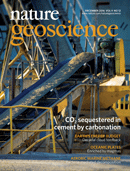TABLE OF CONTENTS
|
December 2016 Volume 9, Issue 12 |
 |  |  |
 |  Editorial Editorial
 Correspondence Correspondence
 Commentary Commentary
 News and Views News and Views
 Letters Letters
 Articles Articles | |
 |
|
 |
 |
Editorial |  Top Top |
 |
 |
 |
A step up for geoengineering p855
doi:10.1038/ngeo2858
The clock is ticking for climate change mitigation. Geoengineering is gaining ground as an option, but it needs to be examined at a large scale to determine its effectiveness and associated risks. |
 |
Correspondence |  Top Top |
 |
 |
 |
Getting to the bottom of the ocean pp857 - 858
Casimir de Lavergne, Gurvan Madec, Xavier Capet, Guillaume Maze and Fabien Roquet
doi:10.1038/ngeo2850 |
 |
Commentary |  Top Top |
 |
 |
 |
No fudging on geoengineering pp859 - 860
Andy Parker and Oliver Geden
doi:10.1038/ngeo2851
The Intergovernmental Panel on Climate Change is preparing a report on keeping global warming below 1.5 °C. How the panel chooses to deal with the option of solar geoengineering will test the integrity of scientific climate policy advice. |
 |
News and Views |  Top Top |
 |
 |
 |
|
 |
Letters |  Top Top |
 |
 |
 |
Impact of decadal cloud variations on the Earth's energy budget pp871 - 874
Chen Zhou, Mark D. Zelinka and Stephen A. Klein
doi:10.1038/ngeo2828
Cloud feedbacks strongly influence the magnitude of global warming. Climate model simulations show that these feedbacks vary strongly as the spatial patterns of sea surface temperatures change over time.
See also: News and Views by Mauritsen |
 |
Tropospheric ozone change from 1980 to 2010 dominated by equatorward redistribution of emissions pp875 - 879
Yuqiang Zhang, Owen R. Cooper, Audrey Gaudel, Anne M. Thompson, Philippe Nedelec et al.
doi:10.1038/ngeo2827
Ozone is an air pollutant and a greenhouse gas. Simulations with a global chemistry transport model reveal that the spatial distribution of ozone precursor emissions dominates the global ozone burden, and that emissions in the tropics matter most. |
 |
Substantial global carbon uptake by cement carbonation pp880 - 883
Fengming Xi, Steven J. Davis, Philippe Ciais, Douglas Crawford-Brown, Dabo Guan et al.
doi:10.1038/ngeo2840
Cement production is a source of CO2. Analysis of carbonation, a process that sequesters CO2 during the lifetime of cement, suggests that between 1930 and 2013, it has offset 43% of CO2 emissions from cement production globally. |
 |
Marine methane paradox explained by bacterial degradation of dissolved organic matter pp884 - 887
Daniel J. Repeta, Sara Ferron, Oscar A. Sosa, Carl G. Johnson, Lucas D. Repeta et al.
doi:10.1038/ngeo2837
A lot of methane is emitted from oxygenated seawater, where its production should be inhibited. Seawater incubations and organic matter characterizations reveal that bacteria aerobically produce methane from phosphonates in organic matter. |
 |
Pacific carbon cycling constrained by organic matter size, age and composition relationships pp888 - 891
Brett D. Walker, Steven R. Beaupre, Thomas P. Guilderson, Matthew D. McCarthy and Ellen R. M. Druffel
doi:10.1038/ngeo2830
Organic matter represents a large pool of carbon in the ocean. Radiocarbon and chemical analyses suggest that larger particles are preferentially remineralized in the Pacific Ocean, with smaller particles and molecules persisting longer.
See also: News and Views by Amon |
 |
Articles |  Top Top |
 |
 |
 |
Regional energy budget control of the intertropical convergence zone and application to mid-Holocene rainfall pp892 - 897
William R. Boos and Robert L. Korty
doi:10.1038/ngeo2833
Shifts in the latitude of the tropical rainfall band are constrained by meridional energy fluxes. Calculations show that combining zonal and meridional energy fluxes can explain past regional rainfall variations like the African Humid Period.
See also: News and Views by Donohoe |
 |
Pre-subduction metasomatic enrichment of the oceanic lithosphere induced by plate flexure pp898 - 903
S. Pilet, N. Abe, L. Rochat, M.-A. Kaczmarek, N. Hirano et al.
doi:10.1038/ngeo2825
Oceanic lithosphere is recycled into the mantle at subduction zones. Analysis of fragments of lower oceanic lithosphere brought to the surface by petit-spot volcanoes suggests this lithosphere may be enriched by melts prior to subduction.
See also: News and Views by Snow |
 |
Recycling of subducted crustal components into carbonatite melts revealed by boron isotopes pp904 - 908
Samuel R. W. Hulett, Antonio Simonetti, E. Troy Rasbury and N. Gary Hemming
doi:10.1038/ngeo2831
The origin of carbon-rich magmas is unclear. Boron isotopic analysis of carbonatite magmas that formed over the past 2.6 billion years reveals a link to carbon recycled during tectonic plate subduction. |
 |
Rapid mantle-driven uplift along the Angolan margin in the late Quaternary pp909 - 914
R. T. Walker, M. Telfer, R. L. Kahle, M. W. Dee, B. Kahle et al.
doi:10.1038/ngeo2835
Mantle flow can warp Earth's surface. Reconstructions of surface deformation in Angola over the past 45,000 years reveal rapid uplift of about 2 mm per year, implying that mantle-induced uplift may occur in quick pulses.
See also: News and Views by White |
 |
 Top Top |
 |
 |
 |  |  |  |  |  | Natureevents is a fully searchable, multi-disciplinary database designed to maximise exposure for events organisers. The contents of the Natureevents Directory are now live. The digital version is available here.
Find the latest scientific conferences, courses, meetings and symposia on natureevents.com. For event advertising opportunities across the Nature Publishing Group portfolio please contact natureevents@nature.com |  |  |  |  |  |
|
 |


No comments:
Post a Comment